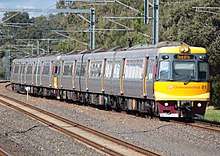Siding (rail)

.jpg)

A siding, in rail terminology, is a low-speed track section distinct from a running line or through route such as a main line or branch line or spur. It may connect to through track or to other sidings at either end. Sidings often have lighter rails, meant for lower speed or less heavy traffic, and few, if any, signals. Sidings connected at both ends to a running line are commonly known as loops;[1][2] those not so connected may be referred to as single-ended or dead-end sidings,[3] or (if short) stubs.[4]
Functions
Sidings may be used for marshalling (classifying), stabling, storing, loading, and unloading vehicles.[5]
Common sidings store stationary rolling stock, especially for loading and unloading. Industrial sidings (also known as spurs) go to factories, mines, quarries, wharves, warehouses, some of them are essentially links to industrial railways. Such sidings can sometimes be found at stations for public use; in American usage these are referred to as team tracks (after the use of teams of horses to pull wagons to and from them). Sidings may also hold maintenance of way equipment or other equipment, allowing trains to pass, or store helper engines between runs.
Some sidings have very occasional use, having been built, for example, to service an industry, a railway yard or a stub of a disused railway that has since closed. It is not uncommon for an infrequently-used siding to fall into disrepair.
Passing siding
A particular form of siding is the passing siding (U.S. and international) or passing loop (U.K.). This is a section of track parallel to a through line and connected to it at both ends by switches (U.S.) (points in international usage). Passing sidings allow trains travelling in opposite directions to pass, and for fast, high priority trains to pass slower or lower priority trains going the same direction. They are important for efficiency on single track lines, and add to the capacity of other lines.
Refuge siding
Single-ended (or dead-end) siding with similar purpose to passing loop.
See also
- Marshalling yard (international) or classification yard (U.S.)
- Rail yard
References
Bibliography
- Jackson, Alan A. (2006). The Railway Dictionary, 4th ed., Sutton Publishing, Stroud. ISBN 0-7509-4218-5.
- Ellis, Iain (2006). Ellis' British Railway Engineering Encyclopaedia. Lulu.com. ISBN 978-1-8472-8643-7.
- Riley, Joseph E. and Strong, James C., "Basic Track", AREMA, 2003
- Solomon, Brian, "Railway Signalling", 1st Edition, Voyageur Press.
